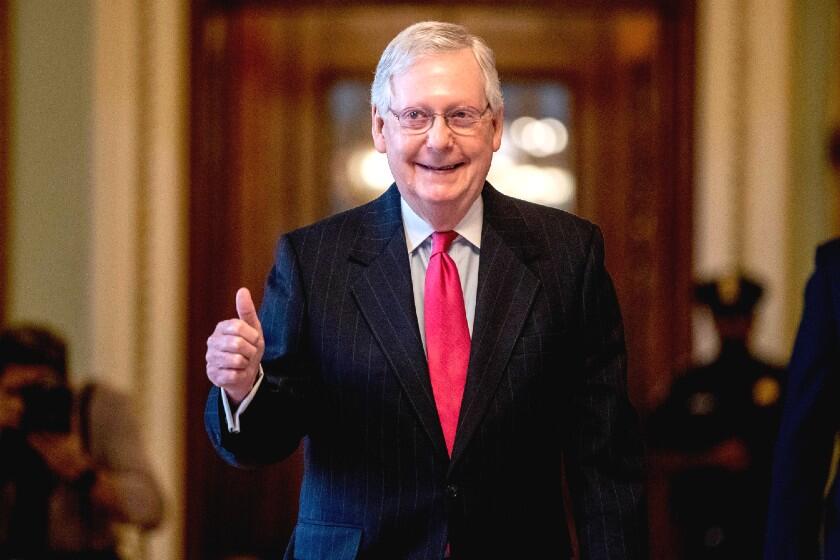Trump seems to think money is free right now. It isn’t

- Share via
President Trump proclaimed himself the “king of debt” during the 2016 campaign, and he does have a long history of borrowing huge amounts that he often repays. So it was curious to see a tweet from him on Tuesday that grossly misstated the cost of federal borrowing.
In the tweet, Trump reaffirmed his on-again, off-again support for a giant federal effort to improve roads, bridges and other infrastructure in this country. He famously reached a deal with top congressional Democrats in April 2019 to support a $2-trillion program of upgrades, only to lose interest in the idea. But Democrats have never given up on the idea of a huge, debt-financed effort to rebuild and improve U.S. infrastructure, and the idea has taken on new urgency in recent weeks as a way to help stimulate the plunging economy.
More on the wisdom of that in a bit. But first, here’s the argument Trump offered for making a massive investment in infrastructure now:
The “ZERO” Trump is referring to is the target the Federal Reserve has set for short-term interest rates. But the Treasury doesn’t finance the federal government’s $18-trillion public debt by borrowing the money 30 days at a time. Instead, it issues a mix of short- and long-term securities, and it expects to pay $482 billion in interest on the public debt this fiscal year. That works out, on average, to an annual interest rate of 2.6%.
With the global economy tanking and investors snapping up Treasury notes, the interest rates Washington has to pay on the money it borrows have dropped. But they’re not going to be zero. Meanwhile, the total cost of Washington’s borrowing is almost certain to rise, given that the recently enacted $2-trillion economic rescue bill, like the much smaller coronavirus emergency measures passed in previous weeks, is financed entirely with deficit spending. The federal government was already running about $1 trillion in the red annually, so its public debt is easily going to surpass $20 trillion as a consequence of the actions already taken.
(Don’t forget that as the economy slides toward recession, the federal tax receipts will drop, further expanding the deficit.)
Before the COVID-19 pandemic, the federal government was projected to spend more than 10% of its budget on debt service, with that share rising almost to 13% by fiscal 2026. Those are dollars that provide no services, employ no people and deliver no benefits to the taxpaying public. That percentage is going to jump now, thanks to the pandemic and the money Congress is appropriating to get us through it.
Yes, that’s right. Mitch McConnell just blamed the coronavirus pandemic on Democrats fulfilling their moral obligation to impeach President Trump.
Which brings us to the merits of a massive infrastructure package at this moment. Conventional wisdom holds that funding a lot more road, bridge and water projects is a good way to stimulate the economy, in part because it boosts productivity more than many other types of federal spending do. But a recent review of the research on this point found no clear proof that infrastructure spending lived up to its billing. According to the authors, the effectiveness of the approach “likely depends on the nature of the spending, whether it can be implemented quickly, the condition of the existing transportation infrastructure, and the nature of the recession.”
In other words, the devil’s in the details. Today, the best-case scenario is that the downturn will be sharp but brief, with the economy rebounding swiftly after the outbreak is fully contained and the social distancing controls are removed. If that’s the case, pouring a couple trillion dollars into projects that won’t get started for a year or more seems like it would be too much help arriving far too late.
A more likely outcome is that the restrictions that are dragging down the economy will remain in place for months, until testing has scaled up dramatically and at least one effective treatment for COVID-19 is approved. The longer the downturn endures, the more protracted the recovery will probably be. In that case, spending heavily on infrastructure could make more sense, assuming the projects are truly “shovel ready” — a label often used to describe the transportation projects in the 2009 stimulus package, but not always deserved.
One other thing to consider is that, recession or no recession, this country’s infrastructure needs a lot more work than we’ve been giving it. Still, it’s not helpful to pretend that there’s no cost to borrowing the money needed to finance these projects. Given the deep, deep hole Washington is already digging, lawmakers need to tailor their infrastructure ambitions to the unique situation we’re in.
More to Read
A cure for the common opinion
Get thought-provoking perspectives with our weekly newsletter.
You may occasionally receive promotional content from the Los Angeles Times.











